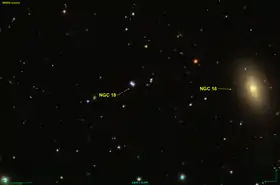NGC 18
NGC 18 is a double star system (both G4) system located in the constellation of Pegasus.[1] It was first recorded by Herman Schultz on 15 October 1866. It was looked for but not found by Édouard Stephan on 2 October 1882. It was independently observed by Guillaume Bigourdan in November 1886.
 | |
| Observation data Epoch J2000 Equinox J2000 | |
|---|---|
| Constellation | Pegasus[1] |
| Right ascension | 00h 09m 23s[1] |
| Declination | +27° 43′ 56″[1] |
| Apparent magnitude (V) | 14[1] |
| Other designations | |
| Database references | |
| SIMBAD | Pul-3 10207 |
| Pul-3 10208 | |
Both stars are 2528±20 light-years away, and based on this distance have a minimum separation of approximately 2,700 astronomical units, an unusually wide separation for a binary system.
References
- Seligman, Courtney (March 2010). "NGC Objects: NGC 1 - 49". Celestial Atlas. Retrieved 27 October 2010.
- "Pul-3 10207". SIMBAD. Centre de données astronomiques de Strasbourg. Retrieved 31 January 2018.
- "Pul-3 10208". SIMBAD. Centre de données astronomiques de Strasbourg. Retrieved 31 January 2018.
See also
- Double star
- Binary star
- List of NGC objects (1–999)
This article is issued from Wikipedia. The text is licensed under Creative Commons - Attribution - Sharealike. Additional terms may apply for the media files.